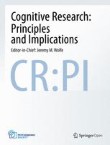Cognitive Research: Principles and Implications is affiliated with The Psychonomic Society
The interactive functional biases of manual, language and attention systems
Hemispheric lateralisation is a fundamental principle of functional brain organisation. We studied two core cognitive functions—language and visuospatial attention—that typically lateralise in opposite cerebra...
